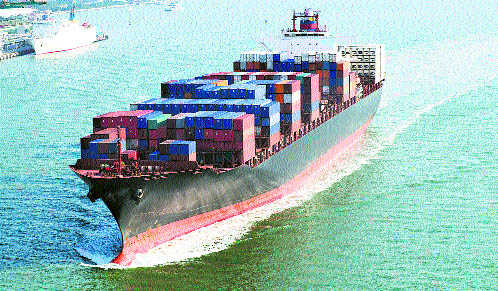
What is needed is a dramatic turnaround in export growth over the next few years.
Sushma Ramachandran
THE Obama administration’s recent comments that the US would like to see India more “deeply embedded” in regional and global trade architecture are a timely reminder that the country needs to make a big push to raise exports. The remarks were in the context of India’s prospects of becoming a member of the Asia Pacific Economic Cooperation (APEC) group but highlight the fact that the Modi government seems to have put trade promotion on the back burner.
This is reflected in the latest official data on exports which have been showing a consistently declining trend in the current fiscal. Exports fell for the seventh consecutive month in June to $22.29 billion, which was nearly 16 per cent lower than the previous year. Cumulative exports for the first quarter of the current fiscal (April to June) are also 16.75 per cent lower than in the corresponding quarter of the previous year — $66.69 billion as compared to $80.11 billion.
The reasons are not far to seek. First, the decline in crude oil prices in world markets, which has come as a bonanza in terms of a lower import bill, has had quite the reverse impact on export growth. Demand for goods like gems and jewellery, which was previously high, especially in oil-producing countries, has slumped considerably. The dip in world oil prices has also hit India’s exports of petroleum products that comprise as much of 22 per cent of our total exports. The country has a sizeable refining capacity and this is being effectively used nowadays to convert imported crude oil into value added petroleum products.
Secondly, the overall global demand has also fallen, owing to the continuing recessionary conditions in major markets like Europe. The crisis in Greece is merely symptomatic of sluggishness in other European economies like Spain, Portugal and Italy. Even in the US, where economic growth has picked up, the pace of revival is slow.
Yet a third factor impeding export growth is the appreciation of the rupee against the euro, which has made Indian products uncompetitive in the European Union. Though there is always a hue and cry in this country when the currency depreciates, the fact is that it is good news for exporters. China, for instance, keeps its currency, the yuan, depreciated to ensure that exports are competitive. There have been concerns in recent years during the G-20 meetings over similar competitive currency depreciations by other countries who seek the same advantage as China in world markets. In India, on the other hand, the news of depreciation is received with gloomy commentaries of the country having lost global status. In 1991, when the rupee was depreciated by the then Narasimha Rao government, it was decried as being a loss of face for the country. On the contrary, it needed to have been viewed as part of a deliberate strategy, along with other economic reforms, to boost the country’s languishing economy.
As for the ambitious export target of $350 billion for this fiscal, it is not likely to be met with exports having fallen every month from last December to June this year. Even in 2014-15, exports only touched $310 billion, a marginal decline from the previous year’s level of $314 billion.
The slump is a big setback to the ambitious plans of increasing India’s share of world trade from the current level of 2.07 per cent to 3.5 per cent by 2020. As it is, this percentage fell marginally from 2.12 per cent in 2012 to the current level. This target looks difficult to achieve unless there is a dramatic turnaround in export growth over the next few years. In addition, the plans to double overall exports, including services, from $469 billion to $900 billion by 2020 are an equally uphill task in the current international climate. Services exports, which are now hovering around $160 billion, could perhaps reach the goal, given the strides taken by the information technology industry, but merchandise exports are not in the same league.
In fact, exports are evidently not a high priority for this government, even though Prime Minister Narendra Modi attended the launch of the NDA’s first foreign trade policy announcement in April. In the past, commerce ministers have played a crucial role in ensuring that India’s interests are secured and its voice heard in multilateral fora. Whether it was Murasoli Maran, Arun Jaitley or Kamal Nath, commerce ministers have played a critical role in making India play a leading role in multilateral organisations like the World Trade Organisation. It was Murasoli Maran who made sure that India’s interests on patents were reflected at the WTO while Arun Jaitley and Kamal Nath lobbied to create a group of 20 that protected the emerging economies interests in agriculture.
The present Commerce Minister, Nirmala Sitharaman, on the other hand, has been extremely low key, barring the move to link the signing of the trade facilitation agreement to enhancing agricultural subsidy limits. There is little evidence of India retaining its leadership role on global trade platforms. For instance, India needs to explore the prospects of joining the new Trans Pacific Partnership (TPP) which seems to have eclipsed even APEC. Though its latest agreement seems somewhat opaque, India needs to be represented in the new regional grouping which has leapfrogged onto the world stage recently. Even China is not yet a member. Some studies are now showing that India and South Asia could be isolated by the clout of the 12-member grouping. It is, therefore, time for India to become proactive and explore ways to associate itself with regional trade blocs like this one.
The advent of the Modi administration seems to have coincided with a slump in exports. Some factors may be external but it is also evident that trade promotion is not being accorded high priority. Given the fact that all major developed and emerging economies are big players in world trade, this neglect does not augur well for India’s efforts to achieve faster economic growth.



























